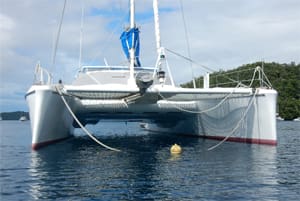Catamarans have been around, especially in the Pacific, for several thousand years. Early islanders sailed large twin-hulled canoes many thousands of miles, generally from Southeast Asia eastward to discover new island homes.
Modern multihull production started with the catamarans of Hawaiian Rudy Choy in 1947. The first cruising catamaran to circumnavigate was his World Cat in 1965. During the 1960s, Prout and Catalac of Great Britain were also starting to produce catamarans. Catamaran production took off in the late 1970s and early 1980s with French builders Fountaine Pajot, Catana, Lagoon and several others producing catamarans for the charter industry. Gemini also started building boats in the U.S. Soon afterward, South African builder St. Francis got started with a 43-foot cat in about 1990, and now a dozen others in South Africa produce about 30 percent of the world’s cruising cats.
After considerable research looking at a number of boats and more than four years aboard, full-time cruising in Southeast Asia, here are our thoughts on some important features to look for in a bluewater cruising catamaran.
Size vs. cost: As with all boats, as size increases, so does cost. We think a 42- to 48-foot cat makes a great cruising home. Any shorter, and sufficient load-carrying capacity for full-time cruising suffers; longer, and the hull and equipment costs skyrocket.
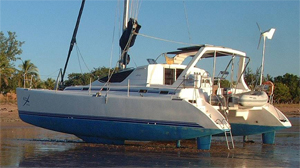 |
|
A stub keel-equipped cat drying out on a beach. |
Bridge deck clearance (BDC): BDC affects the amount of noise in the boat from wave slap, especially while going upwind. We think a catamaran with about 30 inches of clearance is ideal. Increasing the BDC means more windage, which is a negative. Much less than 30 inches, and wave slap becomes a problem in rowdy sea conditions. Longitudinal under-bridge deck fins reduce wave impacts and strengthen the bridge deck. Reducing speed and falling off can also help minimize the problem. Consider how often you actually go close upwind in heavy conditions when cruising versus how much time you spend on other points of sail and in port. The St. Francis 44 has about 24 inches of BDC and it has completed many circumnavigations. However, that does not mean its BDC is ideal.
Load carrying capacity (LCC): Larger boats have more LCC for fuel, water, stores and equipment. Boats with finer hulls are faster than boats with fat hulls, but they will have less LCC. Most full-time cruisers will need at least 5,000 pounds of LCC. When asking this question, make sure you know the hull weight facts and what is included or not. Overloading a cat adversely affects speed, stability and BDC.
Beam-to-length (B/L) ratio and stability: For boats in the 42- to 48-foot range, the B/L ratio should be around 50 percent. Less than that will adversely affect stability in heavy beam winds, but larger boats can be okay with slightly less. A higher ratio adversely affects sailing characteristics. Most modern cats are in that range; older cats are somewhat narrower but also have shorter rigs. For more on this important characteristic, search the Internet for “catamaran stability.”
Integrity and quality of build: There is a big difference in build quality across manufacturers of catamarans. Things to look for include builder reputation, hardware quality and strength, use of lightweight construction materials, anodizing vs. painting of aluminum extrusions, interior woodwork finish, exterior design, and equipment quality and installation technique. If water enters older cats made of cored balsa or plywood, there are often maintenance problems. A good construction practice is to make the underwater hulls of solid fiberglass, and the topsides and decks of foam-cored fiberglass. Solid underwater sections are more impact resistant and easier to repair; they also make adding thru-hulls less of a problem. But they do add weight. If enough of the boat is made with lightweight cored fiberglass, the hull will not sink in case of a major collision or capsizing. This is a major catamaran safety feature, as it is always better to be upside-down on the surface than right-side up on the bottom.
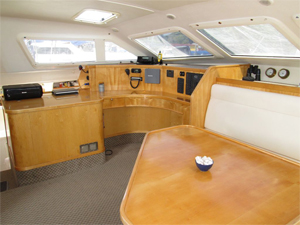 |
|
A large navigation station and office properly located. |
Engine and power train: Having two engines is a major catamaran benefit. Engine and sail drive location on a lightweight catamaran affects pitching in a seaway, so a central location is better for weight distribution. However, a watertight bulkhead between an aft engine room and main cabins can prevent major flooding in case of shaft or sail drive damage. Engines under bunks or accessible only from aft deck hatches are a problem for routine maintenance and underway repairs, especially in rough weather. Sail drives simplify installations but aren’t as robust as a traditional transmission and shaft installation. From a maintenance standpoint, ensure you can perform routine maintenance easily and remove the engine from the boat if necessary. I consider our amidships engines ideal, but my wife does not agree that the galley is a good place for an engine.
Stub keels vs. daggerboards: Most cruisers prefer stub keels over daggerboards because they allow for drying out on the keel bottoms, can give extra tankage and a double bottom, include a deep bilge, and protect props and rudders from grounding damage. Daggerboards allow slightly higher pointing ability and speed in a narrow, upwind steering angle. However, the trunk and board are hard to clean and paint, the board is vulnerable to grounding and floating debris, and it can get stuck. Most modern catamarans built for cruising feature well-designed stub keels using NACA foil specifications.
Rigging and sails: In order to help prevent losing the mast if a standing rigging component fails, doubled shrouds and headstays are better than singles. We prefer mechanical wire end fittings because in case of a wire failure overseas we would be able to replace it ourselves. There should be sufficient winches to handle all sheets, halyards and reefing lines in an efficient manner. Pay particular attention to how easily reefing is accomplished. Can a light-air sail, a boom vang and preventers be accommodated? Will the mast height allow passage under the 65-foot height restriction for the U.S. inland waterways?
Helm placement: The primary helm station should be well out of the weather, have unobstructed visibility to all four corners of the boat, be quickly accessible from the cockpit, and have all controls and instruments available. Double helm stations, especially those aft on the hull decks and flying bridges, as well as those requiring looking through the saloon windows to see forward, can all be problematic. We think the best option is a single helm station on the forward cockpit bulkhead, well protected from wind and water, and with a good view in all directions — especially forward. Some modern catamaran designs feature a single-level main cabin overhead and cockpit top, which may conflict with the above desirable features.
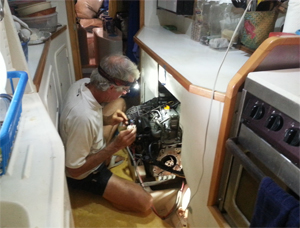 |
|
Chief engineer (author Dave McCampbell) comfortably at work on the port amidships engine. |
Galley location: For those subject to seasickness, galley location can be a personal issue. But for cats less than about 48 feet, locating a large galley with adequate storage in the saloon is a problem. A galley, navigation/office station, dinette table and seating, and three entry/exits are all competing for space there. Further, an adequately sized and located navigation station, galley clutter and light contamination underway are potential problems in “galley up” boats. However, ventilation, crew interaction and seasickness issues are sometimes improved. Ideally, a large refrigerator, pantry and significant galley storage would all be co-located and on the same level with the galley. “Galley up” may be attractive, especially on weeklong charters with guests, but for the other reasons, we prefer the “galley down” arrangement for full-time cruising.
Navigation station: When full-time cruising, the navigation station becomes important for navigating, communicating and office use. Additionally, the circuit breaker panel, most electronics and battery/charging controls should be located there. Ideally, it would be positioned forward in the saloon with a comfortable seat and a good view forward.
Ground tackle: As one of the more heavily loaded systems on a cruising boat, high strength and no weak links are important for all ground tackle equipment. Look for double anchor rollers, strong bridle attachment fittings and good ground tackle storage arrangements. One of the better bridle attachment points is at the bow crossbeam to hull fittings. These should be exceptionally strong, and many boats have specially designed attachment fittings here. Ensure bridle-to-chain attachment fittings are full strength, removal can be done quickly, muddy chain can be washed effectively and that the chain locker is deep enough to minimize chain castles. The windlass should be robust enough to handle the boat’s ground tackle in at least gale conditions. Choose your anchors carefully; large scoops, like the Spade or Rocna, perform much better than older designs.
Decks: Uncluttered and relatively flat decks are preferred for safety at sea. Nonskid needs to be aggressive enough to ensure no crew slippage when wet. Fittings should be very robust and of quality construction. At least six large cleats should be very strongly mounted with large backing plates to spread out heavy loads. Many modern cats have little or no exposed teak — a feature I appreciate.
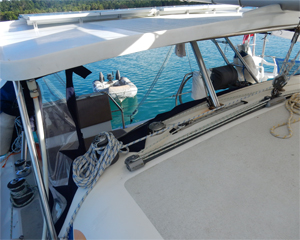 |
|
Rain-catching hardtop with solar panels and boom crutch. |
Bows and rudders: Bows and rudders should be strongly reinforced on their leading edges and designed so as not to catch lines and logs underway. Modern vertical and reverse stems, as well as spade rudders, have more of a problem with this than traditional skeg-hung rudders and bow shapes. Both keels and rudders should be designed to NACA specifications in order to perform efficiently.
Liquid capacities: For full-time cruising overseas, we think an onboard fuel capacity for a 1,200-nm range on one engine and about three weeks of water are ideal. At our average use of about seven gallons per day, about 150 gallons gives us more than 20 days of water. That is enough for many long ocean passages if there is no rain and the watermaker quits. Many modern charter cats have a large water capacity but a small one for fuel.
Watermaker: A large-capacity (approximately 40 gallons per hour) watermaker makes good sense in order to reduce the unit’s run time and the weight of stored fresh water aboard. Simple mechanically driven units are far less expensive, are less of a maintenance problem and can have higher capacity than 12-volt electrical units. We almost always are able to run ours when otherwise underway, so there is little need to run it at anchor — and most of the time we can collect sufficient rainwater anyway.
Refrigeration: As full-time cruisers overseas, we prefer a separate front-loading refrigerator for its convenient and quick interior access. However, the freezer needs to be top loading to provide good thermal efficiency. Capacities of up to 10 cubic feet for the refrigerator and 4 cubic feet for the freezer will provide good long-term storage. These are manageable for electrical energy usage, provided good system design and proper insulation values are used. However, many refrigeration boxes are deficient in insulation. The closer the refrigerator is to the galley the better from the cook’s point of view.
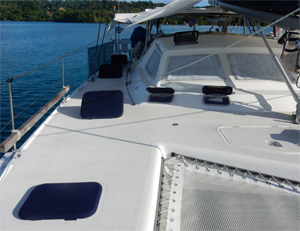 |
|
An example of uncluttered flat decks and no teak needing upkeep! |
Cockpit covers: A well-designed solid cockpit cover should be able to prevent rain from entering the cockpit through the use of removable front and side curtains, facilitate access to the mainsail and the back of the boom, allow for mounting multiple solar panels, and be able to collect a significant amount of fresh rain water. Careful design will prevent water from entering the cockpit during rains while still allowing some ventilation. Ensure the edges won’t drip on the cockpit seats or instruments. Lightweight construction is a plus.
Dinghy davits: Some dinghy davits are incorporated into an arch or tubular support for the cockpit top. These need to be very strongly constructed because the dinghy usually lives there at sea. It should allow hoisting of the dinghy well above the water to help prevent theft and wave slap.
Saloon windows and doors: Extra strength and careful design are required to prevent large breaking waves from flooding the boat and easy entry by an intruder. Thick polycarbonate/Lexan or safety glass is best; acrylic/Plexiglas should not be used. Inspect the window mountings and door hardware carefully for adequate strength and watertightness. Consider main cabin window designs that limit heat entry from the midday sun.
Ventilation: Multiple opening hatches and ports should ventilate every space, especially the saloon, galley, sleeping quarters and heads. We have 14 hatches, six ports and two escape hatches — all opening. Escape hatches provide excellent ventilation, should be large enough for you to pass through, and should be located at least 18 inches above the waterline to prevent flooding while open at anchor. All should be of quality manufacture with tight replaceable seals. Provisions to prevent intruder entry are a plus. Consider how well ventilated the cockpit is in light wind conditions.
Crash bulkheads: Modern catamarans have crash bulkheads located forward and aft in each hull to prevent collision flooding. They should be well sealed from adjacent spaces and have door lips well above the waterline. Obviously, these are not places for heavy gear. Installation of large holding tanks, which are usually empty at sea, can provide a double bottom in the bow.
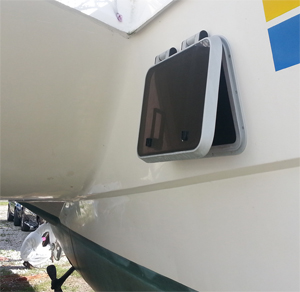 |
|
Good escape hatch location above the DWL. |
There is plenty here to consider before purchasing a cruising catamaran. Many modern cats are built for the lucrative charter trade and have features that may not work well — like minimal fuel storage capacity — for full-time ocean cruising. Some of these can be corrected or improved, some cannot. There is much good information on the Internet, but be suspicious of dealer hype. Ask specific questions and request proof of anything that doesn’t seem right. Make a list of what to look for before going aboard a potential purchase.
Although most cruisers spend 90 percent of their time in port, due consideration should also be given to features that enhance safety and comfort at sea. Most catamarans are optimized for tropics cruising and are probably not the best choices for high-latitude voyaging.
There is no perfect catamaran with all the features you will want, so be prepared to compromise somewhat. Photos and more detail are available on our website below, under a slide presentation titled “Evaluating Modern Catamarans.”
Dave McCampbell is a retired U.S. Navy diving and salvage officer with over 40 years’ cruising and eight sailboats’ worth of maintenance experience. He and his wife, Sherry, have recently cruised the eastern portion of Southeast Asia, including the Philippines, Raja Ampat, Papua New Guinea and the Solomons. Earlier, they spent eight years slowly crossing the Pacific. After 19 years aboard their CSY 44 monohull, they bought a St. Francis 44 Mk II catamaran in 2015.

